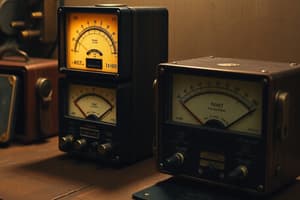Podcast
Questions and Answers
What type of electrical quantity does a voltmeter measure?
What type of electrical quantity does a voltmeter measure?
How are voltmeters typically connected in a circuit for measurement?
How are voltmeters typically connected in a circuit for measurement?
Where should an ammeter be placed in a circuit for accurate measurement?
Where should an ammeter be placed in a circuit for accurate measurement?
What does an ohmmeter measure in an electrical system?
What does an ohmmeter measure in an electrical system?
Signup and view all the answers
Which of the following is a common function of an ohmmeter?
Which of the following is a common function of an ohmmeter?
Signup and view all the answers
What is the main purpose of clamp meters?
What is the main purpose of clamp meters?
Signup and view all the answers
Which electrical measuring tool is used to detect and analyze signal frequency, amplitude, and shape?
Which electrical measuring tool is used to detect and analyze signal frequency, amplitude, and shape?
Signup and view all the answers
What do logic analyzers primarily help engineers analyze?
What do logic analyzers primarily help engineers analyze?
Signup and view all the answers
Which instrument is suitable for measuring voltage, current, and resistance in a single device?
Which instrument is suitable for measuring voltage, current, and resistance in a single device?
Signup and view all the answers
What is a crucial safety consideration when using electrical measuring tools?
What is a crucial safety consideration when using electrical measuring tools?
Signup and view all the answers
Study Notes
Exploring Electrical Measuring Tools
As technology continues to advance, the world of electricity becomes increasingly intricate. To ensure safe, efficient, and reliable operation, we rely on an array of electrical measuring tools. These devices allow us to observe, analyze, and troubleshoot a wide range of electrical systems and components.
Voltmeters
A voltmeter is an instrument used to measure electrical potential differences, also known as voltage. Voltmeters are typically connected in parallel with the circuit to be measured, with their range extending from a few millivolts to thousands of volts. Analog voltmeters display voltage through a needle-and-dial system, whereas digital voltmeters display it numerically.
Ammeters
An ammeter is a device used to measure electric current flowing through a circuit. Ammeters must be connected in series with the circuit being measured, as they need to be placed in the direct current (DC) flow or be part of the alternating current (AC) circuit. Ammeters are available in both analog and digital formats.
Ohmmeters
An ohmmeter is an instrument used to measure electrical resistance. These devices are often used to check wiring, identify short circuits, or test the resistive values of components. Additionally, some ohmmeters include built-in diode and continuity test functions.
Clamps
Clamp meters are non-contact voltage measurement tools that use a clamping mechanism to make measurements without physically connecting to the circuit. Clamp meters are particularly useful for measuring AC currents or voltages in live circuits, reducing the risk of accidental contact with energized wires.
Oscilloscopes
An oscilloscope is an electronic test instrument used to display the waveforms of electrical signals. Oscilloscopes are commonly used for troubleshooting and analyzing AC and DC electrical signals, allowing engineers to detect and analyze signal frequency, amplitude, and shape. Oscilloscopes are available in both analog and digital formats.
Logic Analyzers
A logic analyzer is a digital test instrument used to analyze digital signals. Logic analyzers capture multiple digital signals simultaneously and display them on a computer screen, allowing engineers to analyze complex timing relationships and identify signal glitches, latency issues, or other digital signal problems.
Power Quality Analyzers
Power quality analyzers are instruments that measure and analyze the quality of electrical power supplied to a system. These devices measure factors such as voltage, frequency, harmonic distortion, and power factor, allowing engineers to identify and correct power quality issues that may be affecting the performance of their systems.
Multimeters
A multimeter is an electronic measuring instrument that combines various functions, including voltage, current, and resistance measurement, into a single device. Multimeters are versatile tools that can be used in a variety of applications, making them a popular choice for technicians, electricians, and electronics enthusiasts.
Safety Considerations
When using electrical measuring tools, it is essential to follow safety procedures to prevent injury or damage to equipment. Always turn off power to the circuit before making measurements, ensure that no water or moisture is present, and wear appropriate personal protective equipment, such as safety glasses and grounding wrist straps. Additionally, always refer to the manufacturer's instructions and guidelines when using electrical measuring tools.
Conclusion
Electrical measuring tools are crucial for understanding, analyzing, and troubleshooting electrical systems. By using these instruments, we can gain valuable insights into the behavior of electrical components and circuits, allowing us to optimize and ensure the reliability of our systems. As technology continues to advance, we can expect the development of new and more sophisticated electrical measuring tools that will further enable our understanding of the electrical world.
Studying That Suits You
Use AI to generate personalized quizzes and flashcards to suit your learning preferences.
Description
Dive into the world of electrical measuring tools and learn about voltmeters, ammeters, ohmmeters, clamp meters, oscilloscopes, logic analyzers, power quality analyzers, multimeters, and safety considerations when using these devices. Understand how these instruments help analyze and troubleshoot electrical systems for optimal performance and reliability.




